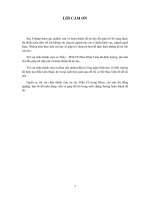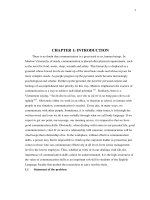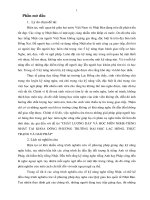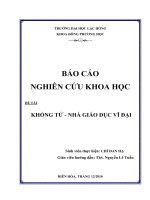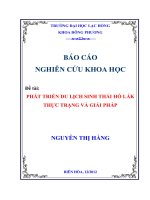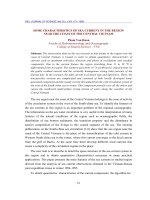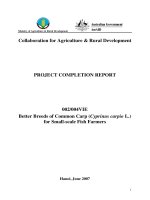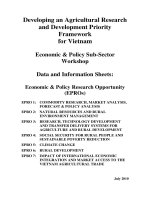Báo cáo nghiên cứu khoa học " Better Breeds of Common Carp (Cyprinus carpio L.) for Small-scale Fish Farmers - Milestone 4 " pptx
Bạn đang xem bản rút gọn của tài liệu. Xem và tải ngay bản đầy đủ của tài liệu tại đây (553.29 KB, 34 trang )
Ministry of Agriculture & Rural Development
Collaboration for Agriculture & Rural Development
002/04VIE Project
Better Breeds of Common Carp (Cyprinus carpio L.)
for Small-scale Fish Farmers
Milestone 4: On-farm Trials and Uptake of Improved Breeds of
Common Carp
Christopher M Austin
1
, Tuan Anh Pham
2
, Binh Thanh Thai
2
, Hung Quang Le
2
1
School of Science and Primary Industries, Charles Darwin University, Darwin Northern
Territory 0909, Australia
2
Research Institute for Aquaculture No 1, Dinh Bang, Tu Son, Bac Ninh, Vietnam
October, 2007
2
Contents
Contents 2
List of Figures 3
List of Table 4
1. Introduction 6
2. Materials and methods 7
2.1. Experimental Design 7
2.2. Selection of common carp strains 8
2.3. Common carp rearing and experimental procedures 9
2.4. Data collection and analysis 11
3. Results 14
3.1. Fingerling growth rate 14
3.2. Growth and survival of HP3 and LOC strains and effects of feed input 14
3.3. Growth rate and survival of HP3, H3B and LOC strains 17
3.4. Growth rate and survival for HP3, VNW and LOC Strains 19
3.5. Growth rate and survival of HP3, H3B, VNW and LOC strains in low feed input
farms controlled for variation among farmer ponds 21
3.6. Common carp biomass production in farms stocked with three common carp strain
(HP3, H3B, LOC) 23
3.7. Common carp biomass production comparing farms stocked with two common
carp strains (HP3 and LOC) 25
3.8. Demand of the improved common carp seed 27
4. Conclusion and Recommendations 29
Appendices 33
Reference 34
3
List of Figures
Fig 2.1. Rice field used for farm trials in Yen Bai province 9
Fig 2.2. Farmer’s pond in Thai Nguyen province 9
Fig 2.3. Measuring common carp 11
Fig 2.4. Ethnic people harvesting common cap in rice field in Yen Bai province 12
Fig 2.5. Harvesting common carp in pond in Thai Nguyen 13
Fig 2.6. A farmer is happy with common carp growth 13
Fig 3.1. Daily growth rate of HP3 and LOC common carp strains in each of 18 farms 15
Fig 3.2. Example of relative growth of three strains of common carp in rice field in Yen
Bai province after six months of culture 18
Fig 3.3. Daily growth rate of HP3, H3B and LOC common carp strain in each of 11 farms
in Yen Bai and Thai Nguyen provinces 18
Fig 3.4. Daily growth rate of HP3, VNW and LOC common carp strain for a period of 10
months in each farm in Yen Bai and Thai Nguyen provinces 20
Fig 3.5. Daily growth rate of HP3, H3B, VNW and LOC common carp strains in 3 farms.
22
Fig 3.6. Common carp from HP3 strain after seven months of cultured in a high input feed
farm in Thai Nguyen province 23
Fig 3.7. Proportion of genetically improved common carp fry and fingerlings cultured in
Vinh Phuc, Thai Nguyen and Yen Bai provinces during 2004-2006 29
4
List of Table
Table 2.1. Farms, pond type, and number of fish stocked of each strain (some farms were
remove from the data set because fish escaped during flooding) 10
Table 2.2. Data analyses for common carp culture farm trails 13
Table 3.1 Mean (± SD) of body length and weight of fingerling carp after 60 days of
nursing 14
Table 3.2. ANOVA table testing for differences in daily growth rate in relation to the
effects of common carp strain (HP3 and LOC) and type of feed input 15
Table 3.3. Daily growth rate of HP3 and LOC common carp strain for period of 10 months
in 18 farms in two type of feeding regimes in Yen Bai and Thai Nguyen provinces.
Superscripts indicate significant differences among groups based on Tukey’s test.
15
Table 3.4. ANOVA table testing for differences in survival rate in relation to the effects of
common carp strain (HP3 and LOC) and type of feed input 16
Table 3.5. Survival rate of HP3 and LOC common carp strains grown for a period of 10
months in 18 farms with two types of feeding rates in Yen Bai and Thai Nguyen
provinces. Superscripts indicate significant differences among groups based on
Tukey’s test 16
Table 3.6. ANOVA table testing for differences in daily growth rate in relation to the
effects of common carp strain (HP3, H3B and LOC) 17
Table 3.7. Daily growth rate of HP3, H3B and LOC common carp strains grown for a
period of 10 months in 11 farms in Yen Bai and Thai Nguyen provinces.
Superscripts indicate significant differences among groups based on Tukey’s test.
17
Table 3.8. ANOVA table testing for differences in survival rate in relation to the effects of
common carp strains (HP3, H3B and LOC) 19
Table 3.9. ANOVA table testing for differences in daily growth rate in relation to the
effects of common carp strain (HP3, VNW and LOC) 19
Table 3.10. Daily growth rate of HP3, VNW and LOC common carp strains grown for a
period of 10 months in 5 farms in Yen Bai and Thai Nguyen provinces.
5
Superscripts indicate significant differences among groups based on Tukey’s test.
20
Table 3.11. ANOVA table testing for differences in survival rate in relation to the effects
of common carp strains (HP3, VNW and LOC) 21
Table 3.12. ANOVA table testing for differences in daily growth rate in relation to the
effects of common carp strain (HP3, H3B, VNW and LOC) 21
Table 3.13. Daily growth rate of HP3, H3B, VNW and LOC common carp strains for
period of 10 months in 3 farms in Yen Bai and Thai Nguyen provinces.
Superscripts indicate significant differences among groups based on Tukey’s test.
22
Table 3.14. ANOVA table testing for differences in survival rate in relation to the effects
of common carp strains (HP3, H3B, VNW and LOC) and culture types (low and
high feed input) 23
Table 3.15. Biomass of common carp strains in 11 farms with 3 strains (HP3, H3B and
LOC) and cultured for 300 days in Yen Bai and Thai Nguyen provinces 24
Table 3.16. ANOVA analyses of biomass of HP3, H3B, and LOC common carp strains.25
Table 3.17. ANOVA analysis of biomass of HP3 and LOC common carp strains 25
Table 3.18. Biomass of common carp strains in 18 farms with 2 strains (HP3 and LOC)
cultured for 300 days. Superscripts indicate significant differences among groups
based on Tukey’s test 26
Table 3.19. Biomass of HP3 and LOC common carp strains grown for a period of 10
months in 18 farms with two types of feed input in Yen Bai and Thai Nguyen
provinces 27
Table 3.20. Number of hatcheries and fry nursing farmers in 3 provinces. 27
Table 3.21. Number of common carp fry produced in five hatcheries in Thai Nguyen, Yen
Bai and Vinh Phuc provinces in 2006 28
Table 3.22. Proportion of fry produced from genetically improved common carp lines in
five hatcheries in Thai Nguyen, Yen Bai, and Vinh Phuc provinces in 2006. 28
6
1. Introduction
In Vietnam aquaculture plays a very important role in economic development and food
security for small scale farmers and contributes 35% of Vietnamese protein consumption.
Aquaculture production is increasing at rate of 10% per year and contributes significantly
to the country’s export income (MOFI, 2007).
Common carp is one of the most popular freshwater aquaculture species in Vietnam and is
cultured in pond, cages, reservoir and rice field for household consumption and income
generation. A recent survey of 133 carp farmers indicated that pond and rice field
production are the preferred form of culture systems (98%) with the pond culture the most
common (Austin et al., 2007a). Most farmers culture common carp with up to 8 other fish
species, both indigenous (silver carp, black carp) and exotic (silver grass carp, bighead,
rohu, mrigal, pirapitinga, Tilapia). In polyculture ponds, common carp is the predominate
species making up 30.1% of the biomass based on a recent survey (Austin et al., 2007a).
The level of culture intensity for common carp varies from small scale extensive farming,
with fish deriving all their nutrition from natural pond productivity, through semi-
intensive farming using fertilization from organic material such as bran, agriculture by-
products and household wastes to high intensive culture system with high stocking
densities and the use of manufactured fish foods. Semi-intensive culture systems are the
most popular in Vietnam using ponds or a combination of ponds and rice field cultivation
(Austin et al., 2007a).
There are many factors that affect production and yield of farmed fish species, including
seed (fry and fingerlings) quality, feed type and rate, fertilisation and pond management,
including water exchange. Of these, seed quality, which is directly related to the genetic
quality of the broodstock used to produce the fry and fingerlings, has been identified as
being of major concern to researchers (Thai et al., 2006; 2007), but which is not generally
understood by farmers to be a potential issue affecting farm productivity (Austin et al.,
2007a).
7
In Vietnam there are many different local varieties of common carp that have been used
by farmers but they usually have small size and low growth rate (Tran, 1983). Over recent
times the Research Institute for Aquaculture No.1 (RIA-I) has bred genetically improved
common carp strains to enhance the productivity of small scale fish farms that utilise this
species. This program has used crossbreeding and mass and family selection
methodologies to produce genetically improved strains and is considered to have achieved
an average increase of 5% in growth rate per generation over a number of generations
(Thien and Thang, 1992). However, all the selective breeding and associated growth trials
have been conducted in research ponds, often without the availability of unselected lines
as control populations for comparative studies.
As a consequence, on-farm growth trials of different strains were undertaken to allow for a
more effective analysis of carp growth under environments directly relevant to small scale
carp farmers and as a strategy to encourage uptake by farmers of genetically improved
strains. This report presents, firstly, a report on the statistical analysis of growth and
production of different common carp strains in small scale farmer ponds in Yen Bai and
Thai Nguyen provinces. The farmers participating in this research project included those
using both pond and rice field culture from mostly highland environments. All farmers
had previously participated in the socio-economic survey and one of two workshops on
fish breeding and genetic improvement conducted as part of this project. Secondly, a
survey of the uptake of improved breeds by producers is presented.
2. Materials and methods
2.1. Experimental Design
The original objective of the on-farm trials was to compare a genetically improve carp
strain and a local strain communally reared in six ponds owned by different farmers. With
additional support from the Research Institute of Aquaculture No. 1 (RIA1), the
experimental objectives were scaled up to include 37 separate farmers and four strains.
The majority (34) of farmers used ponds as their culture systems with six farmers using
8
rice field systems, which reflects the proportion of these different farming systems in these
provinces based on the socio-economic survey (Austin et al., 2007a) (Fig 2.1&2.2). Farms
were classified according to their levels of feed inputs as either high or low to determine if
this important management aspect influenced the relative performance of the different
carp strains. Farmers who did not provide food more than once per month were classified
as having “Low” input pond systems and those who fed at least once per week or more
frequently were classified as having “High” input pond systems. The experiment was
conducted over a 12 months period from March 2006 to March 2007, which included
spawning and fry rearing March – May, 2006 and fingerling grow out May 2006 to March
2007, which largely coincides with the normal carp farming culture cycle. The trials were
conducted in pond systems owned by 20 households in each of the Thai Nguyen and Yen
Bai provinces. Representatives of these households were interviewed for the socio-
economic survey and participated in one of the farmer workshops on fish breeding and
selection held as part of this project.
As described in more detail below the experimental design could not be achieved due to
differential reproduction and survival of fry. Thus different farms were stocked with
different numbers of strains and in varying combinations. Further, fish could not be
harvested from several farms due to flooding and other management problems. Appendix
1 lists the farms that participated in the project, and details of their culture systems and
fish that were stocked and if data collection at harvest was possible.
2.2. Selection of common carp strains
Fours common carp strains were used for growth trials and included one strain (HP3)
recently produced through hybridization between the three blood Hungarian strain and a
recently imported pure line of Hungarian carp, the three blood Hungarian strain (H3B), an
unselected Vietnamese strain (VNW) and a locally available strain (LOC) produced from
broodstock available from the Yen Bai provincial hatchery. Genetic analysis of this strain
(Thai et al., 2006: 2007) indicates it represented a mixture of Indonesian, Hungarian and
Vietnamese strains with the latter strain predominating.
9
.
Fig 2.1. Rice field used for farm trials in Yen Bai province
Fig 2.2. Farmer’s pond in Thai Nguyen province
2.3. Common carp rearing and experimental procedures
Common carp breeding was undertaken at the National Broodstock Centre Hai Duong.
Broodstock of each experimental strain were induced to breed on the same day, using
standard practices for gamete stripping and fertilization (Thai and Ngo, 2004). Between 10
-12 families of fish were obtained from each strain. After fertilization eggs produced from
10
different families of the one strain were pooled and raised in 200l upwelling incubators.
After 4-5 days when larvae had reached 8-12 mm they were transferred to four ponds and
stocked at a rate of 100 larvae/m
2
and grown for a period of two months. Every effort was
made to keep the conditions under which the fry and fingerlings of each strain were raised
as similar as possible, especially in relation to stocking density and feeding regime. When
the fingerlings had reached of 3-5g, they were tagged by using Coded Wire Tag (CWT).
The strains of common carp lines were marked by placing the CWTs on different
locations on the body. The tagged fish were stocked into 40 ponds or pond-rice field
systems over a two day period. Communally stocked fish were in equal proportions with
the exception of three ponds. The details of the fish stocked in farms is given Table 2.1.
Table 2.1. Farms, pond type, and number of fish stocked of each strain (some farms were remove
from the data set because fish escaped during flooding).
Farm Provinces Culture Area Feed
systems
(m
2
)
input HP3
H
3B VNW LOC Total
Hoan Yen Bai Ricefield 1000 HF 100 100 100 300
Ly Yen Bai Pond 800 LF 120 120 240
Thuan Yen Bai Pond 1000 LF 100 100 100 300
Tap Thai Nguye
n
Pond 800 HF 120 120 240
Tuan Thai Nguye
n
Pond 1000 LF 100 100 100 300
Chung Yen Bai Pond 1000 HF 100 100 100 300
Lien Yen Bai Ricefield 1500 LF 113 113 113 113 450
Hom Yen Bai Ricefield 800 LF 80 80 80 240
Tho Yen Bai Pond 450 HF 75 75 150
Dieu Thai Nguye
n
Pond 600 LF 100 100 200
Ha Thai Nguye
n
Pond 1500 LF 113 113 113 113 450
Lieu Thai Nguye
n
Pond 1000 LF 145 55 100 300
Canh Thai Nguye
n
Pond 400 HF 60 60 120
Luat Thai Nguye
n
Pond 1000 LE 100 100 100 300
Nhan Yen Bai Pond 1500 LE 113 113 113 113 450
Truong Thai Nguye
n
Pond 500 HF 75 75 150
Que Thai Nguye
n
Pond 1000 LF 100 50 150 300
Vinh Thai Nguye
n
Pond 800 LF 80 80 80 240
Ke Thai Nguye
n
Pond 550 LF 90 90 180
Thong Yen Bai Pond 1000 LF 100 100 100 300
Lich Thai Nguye
n
Pond 500 LF 75 75 150
Trung Thai Nguye
n
Pond 400 LF 60 60 120
Strain and No of fish stocked
HF: High feeding rate LF: Low feeding rate.
11
Each farm pond or rice field was stocked at a rate of 0.3 fish/m
2
and was classified as
either “Low Feed” or “High Feed” based on the level of food inputs into the ponds. Rice
field systems fed less than once per week were classified as low input systems and more
than once per week as high input.
All experimental ponds and rice fish fields were managed by farmers. Fish in ponds and
rice fields were fed by available foods from farmers’ households such as rice bran, corn
and cassava. A log book was provided to each farmer to keep a record of food inputs into
their experimental pond and other relevant information and this information was used to
classified ponds into high and low feed input. The farmers were visited on a monthly basis
by project staff to assist in record keeping (Fig 2.3).
Fig 2.3. Measuring common carp.
2.4. Data collection and analysis
Inequalities in fry weight among strains after the three month nursing period was tested by
weighing a sample of 30 individuals to the nearest 0.1 g and analysed using a one –way
ANOVA. Prior to this analysis the FMax test was used to determine if variances amongst
strains were homogenous.
12
Pond trials were conducted for 300 – 330 days. Fish were harvesting by draining and by
netting. Data from were collected as fish wet weight to the nearest 0.1 g and length (snout
– caudal) measured to the nearest mm (Fig 2.4, 2.5 & 2.6). Fish were allocated to strain
based on the identification of the position of the CWT using a detector scanner (North
West Marine technology, Shaw Island, WA, American). To compare growth between
strains, fish weights were converted to daily growth rate (DGR) after first subtracting the
mean fingerling weight for that strain.
The appropriate statistical procedure for the experimental design for analyzing for
differences in growth rate is a three-way ANOVA with nesting. The first level of the
analysis allows partitioning of variance due to Feed Input as either low (LF) or high (HF),
the second level is Farmer, which is nested within level 1 and the third level is Fish Strain.
Due to the unequal numbers fry available for each of the four carp strains and their
stocking in different combinations into farms and the unavailability of data from a number
farms, several kinds of ANOVA were conducted. The number of farms with different
combinations of stocked strains is given in Table 2.2 together with the type of ANOVA
conducted.
Fig 2.4. Ethnic people harvesting common cap in rice field in Yen Bai province
13
Fig 2.5. Harvesting common carp in pond in Thai Nguyen
Fig 2.6. A farmer is happy with common carp growth
Table 2.2. Data analyses for common carp culture farm trails
Type of analysis
Low High Total
Three way Anova (HP3, LOC) 14 4 18
Two way Anova (HP3, H3B, LOC) 10 1 11
Two way Anova (HP3, VNW, LOC) 4 1 5
Two way Anova (HP3, H3B, VNW, LOC) 3 3
Farm inputStrains
Percentage of recovered fish and harvested fish biomass of each common carp strain were
analyzed as a 2-way ANOVA. The biomass of fish harvested in ponds with unequal
14
stocking rates was adjusted to the average stocking rate to allow for statistical comparison.
All analyses were conducted using the Excel and SPSS software packages.
3. Results
3.1. Fingerling growth rate
The average weight of common carp fingerlings after 60 days of nursing was 3.18 g. The
average weight of each common carp strain is given in Table 3.1. However, the difference
in body weigh among strains was not significantly different (P>0.05).
Table 3.1 Mean (± SD) of body length and weight of fingerling carp after 60 days of nursing
Carp strain Length (cm) Weight (g)
HP3 4.72 ± 0.70 3.38 ± 1.50
H3B 4.57 ± 0.56 2.82 ± 1.66
VNW 5.36 ± 1.28 4.21 ± 2.84
LOC 4.27 ± 0.74 2.29 ± 1.32
Total 4.73 ± 0.82 3.18 ± 1.83
3.2. Growth and survival of HP3 and LOC strains and effects of feed input
Growth rate for the HP3 and LOC strains were compared in 18 farms which included both
low and high feed input systems. Significant differences were observed for all factors and
for the interaction between production systems and strain (Table 3.2) (P<0.01). The mean
daily growth rate of HP3 strain (0.48g) was 60% higher than that of local strain (LOC)
(0.30g) (Table 3.3). Daily growth rate of each fish farm is present in Fig 3.1.
15
Table 3.2. ANOVA table testing for differences in daily growth rate in relation to the effects of
common carp strain (HP3 and LOC) and type of feed input.
Source Type III Sum of Squares df Mean Square F Sig.
Corrected Model 209.18 20 10.46 329.90 0.00
Intercept 213.32 1 213.32 6728.53 0.00
Farm 76.76 17 4.52 142.42 0.00
Strain 9.52 1 9.52 300.13 0.00
Feed input 9.49 1 9.49 278.62 0.00
Strain * Feed input 5.27 1 5.27 166.26 0.00
Error 25.81 814 0.03
Total 367.36 835
Corrected Total 234.99 834
Table 3.3. Daily growth rate of HP3 and LOC common carp strain for period of 10 months in 18
farms in two type of feeding regimes in Yen Bai and Thai Nguyen provinces. Superscripts
indicate significant differences among groups based on Tukey’s test.
Strain
Low High
HP3
0.22 ± 0.02
a
1.13 ± 0.03
c
LOC
0.16 ± 0.02
b
0.79 ± 0.04
d
Feed input
Fig 3.1. Daily growth rate of HP3 and LOC common carp strains in each of 18 farms.
This last finding is particularly significant as it indicates that while there is a significant
difference among strains, this difference is greatly diminished in production systems with
low feed inputs. Table 3.3 gives the average daily growth rate for the 2 strains in each
0.00
0.50
1.00
1.50
2.00
2.50
3.00
Luat Ha Ke Vinh Tuan Lieu Dieu Que Lich Lien Hom Nhan Thong Thuan Truong Hoan Tap Chung
Farm
DRG (g)
HP3
LOC
Low feeding rate High feeding rate
16
system and it can be seen there is only a 0.06g difference in average daily growth in low
feed input systems compared with a 0.36 in high input system.
The results from an analysis of survival rate of two strains are shown in Table 3.4 and
Table 3.5. There is a significant difference in survival rate between low and high feed
input farms but no significant difference between strains. The survival rate of HP3 and
LOC strains is 24.77% and 22.76% respectively and it is 62% higher in High feed input
ponds compared to Low feed input ponds.
Table 3.4. ANOVA table testing for differences in survival rate in relation to the effects of
common carp strain (HP3 and LOC) and type of feed input.
Source Type III Sum of Squares df Mean Square F Sig
Corrected Model 3366.45 19 177.18 14.88 0.00
Intercept 19547.55 1 19547.55 1641.80 0.00
Strain 36.13 1 36.13 3.03 0.10
Feed input
772.99 1 772.99 9.44
0.00
Strain * Feed inpu
t
3.18 1 3.18 0.27 0.61
Error 190.50 16 11.91
Total 23894.81 36
Corrected Total 3556.95 35
Table 3.5. Survival rate of HP3 and LOC common carp strains grown for a period of 10 months
in 18 farms with two types of feeding rates in Yen Bai and Thai Nguyen provinces. Superscripts
indicate significant differences among groups based on Tukey’s test.
Feed input N Mean Std Min Max
Low 28
21.29
a
0.86 11.72 29.33
High 8
32.44
b
6.31 14.17 62.00
Total 36
26.90
a
3.58 12.95 45.67
17
3.3. Growth rate and survival of HP3, H3B and LOC strains
Growth data from three strains, HP3, H3B and LOC were compared in 11 farms which
included 10 low and 1 high feed input systems. Significant differences were observed for
strain and farmer as presented Table 3.6. Table 3.7 gives the average growth rate for the 3
strains. The effect of the level of feed input could not be tested statistically due lack of
replicates. The differences between strains can be seen from Figure 3.2 and Table 3.7. The
daily growth rate of common carp in each farm is presented in Fig 3.3. Each strain was
significantly different on the basis of Tukey’s test with HP3>H3B>LOC.
Table 3.6. ANOVA table testing for differences in daily growth rate in relation to the effects of
common carp strain (HP3, H3B and LOC).
Source Type III Sum of Squares df Mean Square F Sig.
Corrected Model 60.13 13 4.63 387.22 0.00
Intercept 49.36 1 49.36 4132.25 0.00
Strain 1.84 2 0.92 77.08 0.00
Farm 58.78 10 5.34 447.32 0.00
Error 9.86 825 0.01
Total 133.38 839
Corrected Total 69.99 838
Table 3.7. Daily growth rate of HP3, H3B and LOC common carp strains grown for a period of
10 months in 11 farms in Yen Bai and Thai Nguyen provinces. Superscripts indicate significant
differences among groups based on Tukey’s test.
Strain N Mean Std Min Max
HP3 301
0.33
a
0.34 0.05 1.90
H3B 282
0.26
b
0.27 0.04 1.51
LOC 256
0.23
c
0.23 0.02 1.05
Total 839
0.27d
0.28 0.03 1.49
18
Fig 3.2. Example of relative growth of three strains of common carp in rice field in Yen Bai
province after six months of culture.
0.000
0.200
0.400
0.600
0.800
1.000
1.200
1.400
Luat Ha Vinh Tuan Lieu Que Lien Hoan Nhan Thuan Thong
Farm
DRG (g)
HP3
H3B
LOC
Fig 3.3. Daily growth rate of HP3, H3B and LOC common carp strain in each of 11 farms in Yen
Bai and Thai Nguyen provinces.
ANOVA analyses of survival rate of common carp showed that there was a significant
difference between farms, while survival rate between common carp strains was not
different (Table 3.8). The average survival rate of HP3, H3B and LOC was 24.28%,
25.78%, and 23.45% respectively.
HP3
LOC
H3B
19
Table 3.8. ANOVA table testing for differences in survival rate in relation to the effects of
common carp strains (HP3, H3B and LOC).
Source Type III Sum of Squares df Mean Square F Sig.
Corrected Model 3890.87 13 299.30 15.10 0.00
Intercept 17183.84 1 17183.84 866.98 0.00
Farm 3848.88 11 349.90 17.65 0.00
Strain 50.18 2 25.09 1.27 0.30
Error 376.59 19 19.82
Total 23859.09 33
Corrected Total 4267.46 32
3.4. Growth rate and survival for HP3, VNW and LOC Strains
Growth data from three strains, HP3, VNW and LOC were compared in 5 farms which
included 4 low and 1 high feed input systems. Significant differences were observed for
both strain and farmer factors as presented Table 3.9. Table 3.10 gives the average growth
rate for the 3 strains. While the effect of production system could not be tested statistically
due to lack of replicates for this effect and the differences between strains and farms can
be seen from Figure 3.4. Each strain was significantly different on the basis of Tukey’s
test with HP3>VNW>LOC.
Table 3.9. ANOVA table testing for differences in daily growth rate in relation to the effects of
common carp strain (HP3, VNW and LOC).
.
Source Type III Sum of Squares df Mean Square F Sig.
Corrected Model 4.12 6 0.69 55.05 0.00
Intercept 17.22 1 17.22 1381.20 0.00
Farm 3.13 4 0.78 62.84 0.00
Strain 1.08 2 0.54 43.40 0.00
Error 3.74 300 0.01
Total 25.74 307
Corrected Total 7.86 306
20
Table 3.10. Daily growth rate of HP3, VNW and LOC common carp strains grown for a period
of 10 months in 5 farms in Yen Bai and Thai Nguyen provinces. Superscripts indicate significant
differences among groups based on Tukey’s test.
Strain N Mean Std Min Max
HP3 112
0.31
a
0.20 0.10 1.50
VNW 96
0.22
b
0.12 0.03 0.66
LOC 99
0.18
c
0.10 0.02 0.78
Total 307
0.24
c
0.14 0.05 0.98
0.00
0.10
0.20
0.30
0.40
0.50
0.60
Ha Lien Hom Nhan Chung
Farm
DRG (g)
HP3
VNW
LOC
Fig 3.4. Daily growth rate of HP3, VNW and LOC common carp strain for a period of 10 months
in each farm in Yen Bai and Thai Nguyen provinces.
The results of the survival rate of three common carp strains (HP3, VNW and LOC)
showed no significant differences between farms (Table 3.11). Although survival rate of
HP3 was the highest (20.57%) there had no significant difference comparing with other
two strains (VNW = 17.98% and LOC = 18.49%).
21
Table 3.11. ANOVA table testing for differences in survival rate in relation to the effects of
common carp strains (HP3, VNW and LOC).
Source Type III Sum of Squares df Mean Square F Sig.
Corrected Model 87.19 6 14.53 2.28 0.14
Intercept 5417.29 1 5417.29 850.77 0.00
Farm 68.18 4 17.04 2.68 0.11
Strain 19.01 2 9.51 1.49 0.28
Error 50.94 8 6.37
Total 5555.42 15
Corrected Total 138.13 14
3.5. Growth rate and survival of HP3, H3B, VNW and LOC strains in low feed input
farms controlled for variation among farmer ponds
Growth data from all four strains, HP3, H3B, VNW and LOC were compared in 3 low
input farms in which they were raised communally. Significant differences were observed
for both strain and farmer as presented Table 3.12. Table 3.13 gives the average growth
rate for the 4 strains. Post hoc tests indicated significant differences among strains with
HP3 > H3B = VIET > LOC. Daily growth rate of each strain and farm are presented in Fig
3.5.
Table 3.12. ANOVA table testing for differences in daily growth rate in relation to the effects of
common carp strain (HP3, H3B, VNW and LOC)
Source Type III Sum of Squares df Mean Square F Sig.
Corrected Model 1.53 5 0.31 135.15 0.00
Intercept 7.89 1 7.89 3480.33 0.00
Farm 0.92 2 0.46 203.09 0.00
Strain 0.62 3 0.21 91.25 0.00
Error 0.55 242 0.00
Total 10.65 248
Corrected Total 2.08 247
22
Table 3.13. Daily growth rate of HP3, H3B, VNW and LOC common carp strains for period of 10
months in 3 farms in Yen Bai and Thai Nguyen provinces. Superscripts indicate significant
differences among groups based on Tukey’s test.
Strain N Mean Std Min Max
HP3 71
0.26
a
0.08 0.10 0.46
H3B 62
0.17
b
0.09 0.04 0.38
VNW 58
0.17
b
0.07 0.03 0.38
LOC 57
0.13
c
0.06 0.02 0.24
Total 248
0.18
C
0.08 0.05 0.37
0.00
0.05
0.10
0.15
0.20
0.25
0.30
0.35
0.40
Lien Ha Nhan
Farm
DRG (g)
HP3
H3B
VNW
LOC
Fig 3.5. Daily growth rate of HP3, H3B, VNW and LOC common carp strains in 3 farms.
The results of survival rate comparisons among four common carp strains (HP3, H3B,
VNW and LOC) are showed in Table 3.14. There are significant differences between fish
survival rate among farms (P<0.05) with survival rate of fish in the farms ranged from
20.94 to 16.81 %. There was no significant differences in survival rate between common
carp strains (P>0.05).
23
Table 3.14. ANOVA table testing for differences in survival rate in relation to the effects of
common carp strains (HP3, H3B, VNW and LOC) and culture types (low and high feed input).
Source Type III Sum of Squares df Mean Square F Sig.
Corrected Model 90.87 5 18.17 4.33 0.05
Intercept 4161.47 1 4161.47 991.99 0.00
Farm 57.19 2 28.60 6.82 0.03
Strain 33.68 3 11.23 2.68 0.14
Error 25.17 6 4.20
Total 4277.52 12
Corrected Total 116.04 11
Fig 3.6. Common carp from HP3 strain after seven months of cultured in a high input feed farm
in Thai Nguyen province.
3.6. Common carp biomass production in farms stocked with three common carp
strain (HP3, H3B, LOC)
Common carp production was compared for 3 strains in 11 farms. Biomass of common
carp from 11 farms is presented in Table 3.23. Significant differences were observed
between farms and strains of common carp (Table 3.24). The pair-wise comparison
indicated difference in biomass of common carp between farms and between strains using
Tukey’s test. Biomass of three common carp strains ranged from 3.16g/m
2
(LOC) to
4.80g/m
2
(HP3).
24
Table 3.15. Biomass of common carp strains in 11 farms with 3 strains (HP3, H3B and LOC) and
cultured for 300 days in Yen Bai and Thai Nguyen provinces.
Farm Area Culture Strains Biomass Adjusted
(m
2
)
systems N Weight (g) N
W
eight (g) Sur (%) DGR
(g/m
2
) (g/m
2
)
Hoan 1000 HF HP3 100 3.38 51 385.08 51.00 1.28 19.30 29.72
H3B 100 2.82 62 292.33 62.00 0.97 17.84 27.45
LOC 100 2.29 56 249.49 56.00 0.83 13.74 20.96
Thuan 1000 LF HP3 100 3.38 20 97.43 20.00 0.32 1.61 2.92
H3B 100 2.82 19 82.82 19.00 0.28 1.29 2.36
LOC 100 2.29 19 67.90 19.00 0.23 1.06 1.94
Tuan 1000 LF HP3 100 3.38 30 59.87 30.00 0.20 1.46 2.69
H3B 100 2.82 26 51.43 26.00 0.17 1.05 2.01
LOC 100 2.29 29 49.89 29.00 0.17 1.22 2.17
Lieu 1000 LF HP3 145 3.38 40 61.88 27.27 0.21 1.96 2.53
H3B 55 2.82 10 70.55 19.00 0.24 0.58 2.01
LOC 100 2.29 12 44.82 11.72 0.15 0.30 0.79
Luat 1000 LF HP3 100 3.38 15 28.61 15.00 0.10 0.09 0.64
H3B 100 2.82 14 22.45 14.00 0.07 0.03 0.47
LOC 100 2.29 17 16.10 17.00 0.05 0.05 0.41
Que 1000 LF HP3 100 3.38 36 59.35 36.00 0.20 1.80 3.20
H3B 50 2.80 11 56.74 21.00 0.19 0.46 1.79
LOC 150 2.29 33 53.68 22.00 0.18 1.43 1.77
Vinh 800 LF HP3 80 3.38 20 62.73 25.00 0.21 1.23 2.35
H3B 80 2.82 15 53.78 18.89 0.18 0.73 1.52
LOC 80 2.29 22 46.51 27.50 0.16 1.05 1.92
Thong 1000 LF HP3 100 3.38 22 49.00 22.00 0.16 0.74 1.62
H3B 100 2.82 21 44.00 21.00 0.15 0.64 1.39
LOC 100 2.29 22 35.67 22.00 0.12 0.56 1.18
Lien 1500 LF HP3 113 3.38 25 83.96 22.12 0.28 1.14 2.79
H3B 113 2.82 20 58.72 17.70 0.20 0.57 1.56
LOC 113 2.29 30 41.66 26.55 0.14 0.66 1.66
Ha 1500 LF HP3 113 3.38 20 102.67 17.70 0.34 1.11 2.73
H3B 113 2.82 21 79.93 18.58 0.27 0.91 2.23
LOC 113 2.29 22 54.24 19.47 0.18 0.62 1.58
Nhan 1500 LF HP3 113 3.38 21 59.88 18.58 0.20 0.58 1.67
H3B 113 2.82 16 20.61 14.16 0.07 0.01 0.44
LOC 113 2.29 19 15.66 16.81 0.05 0.03 0.40
Stocking Harvesting
25
Table 3.16. ANOVA analyses of biomass of HP3, H3B, and LOC common carp strains
Source Type III Sum of Squares df Mean Square F Sig
Corrected Model 1634.65 12 136.22 81.95 0.00
Intercept 519.00 1 519.00 312.23 0.00
Farm 1619.77 10 161.98 97.45 0.00
Strain 14.88 2 7.44 4.48 0.02
Error 33.24 20 1.66
Total 2186.89 33
Corrected Total 1667.90 32
3.7. Common carp biomass production comparing farms stocked with two common
carp strains (HP3 and LOC).
ANOVA analysis of biomass of common carp showed that there were significant
differences in biomass between farms, feed input, and the 2 strains (Table 3.25). The
biomass of common carp in two feed input systems are given in Table 3.26 and Table
3.27. The average common carp biomass for each strain in both high and low feed input
systems is given in Table 3.27.
Table 3.17. ANOVA analysis of biomass of HP3 and LOC common carp strains.
Source Type III Sum of Squares df Mean Square F Sig
Corrected Model 1416.77 19 74.57 36.58 0.00
Intercept 1478.65 1 1478.65 725.34 0.00
Farm 557.10 16 34.82 17.08 0.00
Strain 14.75 1 14.75 7.24 0.23
Feed input 844.86 1 844.86 45.84 0.00
Strain * Feed input 3.69 1 3.69 1.81 0.20
Error 32.62 16 2.04
Total 2198.60 36
Corrected Total 1449.39 35
